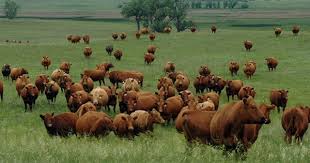With USDA cancelling its regularly scheduled July cattle inventory report due to budget cuts, that’s a question that many would like to have answered. Fortunately, historical relationships between changes in prior and subsequent inventories and levels of cow slaughter in between or heifers’ share of cattle on feed offer some indication. These negative relationships respectively explain 30% and 50% of the variation in changes in cattle inventory from one July to the next. While the share of January cow inventory that is slaughtered by July has dropped from 8.75% in 2003 to 7.76% in 2004, suggesting a slowing of cow herd liquidation, the current level still corresponds to a reduction in the July over July total inventory, as does the proportion of feedlot cattle that are heifers, currently at 39.6% compared to 39.9% last July. A model incorporating both variables explains 61% of inventory changes and estimates the July 1 U.S. cattle inventory to be 94.2 million head or 1.2% lower than in July 2023. Hence, it appears the U.S. cattle industry overall remains in a contractionary phase, even if there may be regional pockets of expansion.
The USDA’s most recent Cattle on Feed report indicates that feedlots placed 1.56 million head on-feed and marketed 1.79 million last June or about 7% fewer placements and 9% fewer marketings than in the prior June, bringing the July 1 total number of cattle on feed to 11.3 million head or just about 1% more than last July. With a 0.8% increase in steers on-feed relative to last July and a nearly unchanged (0.1% increase) number of heifers, the latter’s share of cattle on feed, as already mentioned, also remains similar to a year ago at nearly 40%, as compared to only 31%-33% during much of the last expansion. Such a statistic typically indicates a reduction in replacement heifers, as producers remain reluctant to rebuild the breeding herd.
Given the low inventory and cattle on feed numbers, beef production is anticipated to be 1.1% lower in 2024 than last year and then drop another 4.5% in 2025. Accordingly, per capita beef consumption is expected remain near 58 pounds per person in 2024 and then decrease 3.26% to 56.3 pounds per person in 2025. Based on stronger than anticipated global demand, the USDA in its Livestock, Dairy, and Poultry Outlook revised projections of beef exports upward, now just 4.3% lower this year than the last and left unchanged a further 14.0% projected decline for 2025. Following records in 2021 and again in 2022, beef exports dropped about 14.3% lower in 2023, and the 2024 projection returns to within 1.5% of the 2020 level, while projected declines for 2025 bring beef exports down to levels not seen since 2016. Still, as a result of currently strong demand and declining production, cold stocks of beef are already fairly low. According to the USDA’s June Cold Storage Report beef stocks on May 31 are down 3.4% from a month earlier and 0.5% from last year.
All things considered, prices are likely to remain above year ago levels. Quarterly prices for slaughter steers are forecast to average about $191.48/cwt and $199.08/cwt for the last two quarters of 2024, and $204.60/cwt and $209.12/cwt for the first two quarters of 2025. For 600-700 pound feeder steers, prices are forecast to average about $286.38/cwt and $277.88/cwt for the last two quarters of 2024, and $293.31/cwt and $301.50/cwt for the first two quarters of 2025. These projections reflect tight supplies and declining but resilient domestic consumption and export demand. If demand declines even more than anticipated or a larger herd exists than indicated by this analysis, then lower prices may result.
Jason Franken -- University of Illinois at Urbana-Champaign










